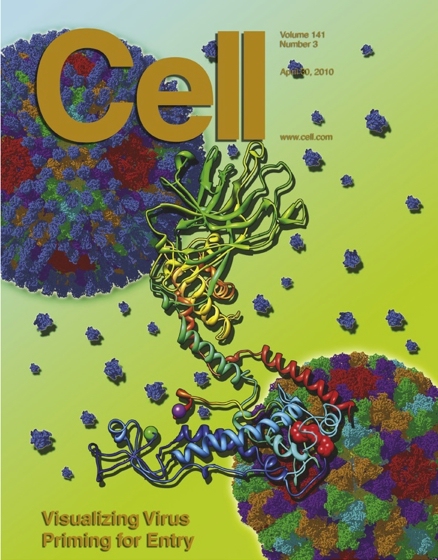A remarkable progress on the penetration mechanism of non-enveloped dsRNA virus
Date:03-06-2010 | 【Print】 【close】

Cell, the international leading scientific journal, published a coverpaper entitled: “3.3 Å Cryo-EM Structure of a Nonenveloped Virus Reveals a Priming Mechanism for Cell Entry” in the issue of April 30, 2010 (Seeing http://www.cell.com). This achievement came from a joint research between Professor Qin Fang’s group from Wuhan Institute of Virology, Chinese Academy of Sciences, and Professor Hong Zhou’s labfrom University of California, Los Angeles, USA. A long-term collaboration between the two groups led to the new finding.Grass Carp Reovirus (GCRV) is believed to be an ideal model for studying the penetration mechanism of nonenveloped dsRNA viruses. By combining molecular biology and singe-particle cryo-electron microscopy, the two groups obtained super high-resolution images of the primed Aquareovirus ISVP (infectious subviral particle) at 3.3 angstroms resolution, including six conformers of membrane penetration protein VP5 and three core proteins with a total of nearly 5000 residues. The finding demonstrated the dynamic conversion process of the membrane penetration protein during entry into the host cell, transforming from a dormant, stable state into a metastable, primed state. The achievement improved our understanding of how nonenveloped dsRNA viruses gaining access into the cell and provided a structural basis for viral disease control and prevention.
Compared with enveloped viruses (e.g., influenza virus), the membrane penetration mechanism of nonenveloped viruses has been poorly understood. As a member of the State Key Laboratory of Virology in Wuhan Institute of Virology, Chinese Academy of Sciences, the main interest of research group for Aquatic Virus & Structure and Function of Viruses focuses on the molecular biology characteristics and structural basis of the reoviruses isolated from humans, mammalians, aquatic animals, plants and insects, exploring the endogenous transcription mechanisms involved within dsRNA viruses and the function of outer capsid proteins in virus-cell interaction by using GCRV as model.
By constructing mutated recombinant virus, and in vitro expression of mutated outer capsid protein for further recoating with the virus core, we try to get better understanding of the cell entry mechanism of nonenveloped virus and ultimately to block virus infection.
